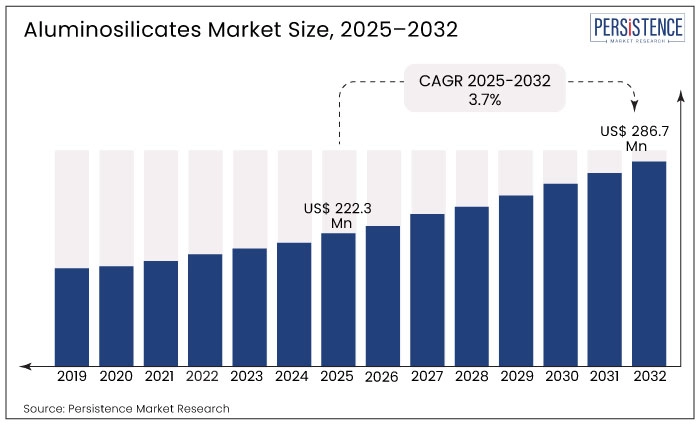ID: PMRREP10879| 198 Pages | 29 Jul 2025 | Format: PDF, Excel, PPT* | Chemicals and Materials

According to Persistence Market Research, during the assessment period (2025 to 2032), the global aluminosilicates market is expected to grow at a CAGR of 3.7% and increase from its market value of US$ 222.3 million to US$ 286.7 million by the end of 2032.
Aluminosilicates are a group of minerals composed of aluminum (Al), silicon (Si), and oxygen (O) atoms. The consideration made for the study includes andalusite, sillimanite, kyanite, kaolin, and feldspar. These minerals have complex crystal structures and are abundant in the Earth's crust. Aluminosilicate minerals find applications in different industries due to their properties such as high thermal stability and resistance to heat. They are used in the production of refractory materials, ceramics, porcelain, glass, and various other products.
Aluminosilicates are widely used in the production of cement, concrete, and ceramics, which are essential materials for infrastructure development. Growing urbanization and industrialization in emerging economies has been fueling market growth over the years.

The electronics industry also played a vital role in driving the demand for aluminosilicates. Aluminosilicate glass, known for its high strength and resistance to thermal shock, is extensively used in electronic devices such as smartphones, tablets, and televisions. The chemical industry's expansion too contributed to this market's growth, since aluminosilicates are used as catalysts, absorbents, and molecular sieves. These materials have excellent adsorption and ion-exchange properties, making them valuable in various chemical processes.
| Attributes | Key Insights |
|---|---|
|
Aluminosilicates Market Size (2025) |
US$ 222.3 Million |
|
Forecasted Market Value (2032) |
US$ 286.7 Million |
|
Value CAGR (2025 to 2032) |
3.7% |
| Historical Market Growth Rate (CAGR 2019 to 2024) | 3.2% |
One adjacent market is the silica market. Silica, also known as silicon dioxide, is a key component of aluminosilicates and finds wide applications in glass manufacturing, electronics, construction, and chemicals. Silica is used in the production of glass, ceramics, silicon wafers for semiconductors, and as a filler in various materials. While aluminosilicates offer additional properties due to the presence of aluminum, silica has its distinct applications and market demand.
Another adjacent market is the cement and concrete industry. While aluminosilicates are used as additives in cement and concrete production, these industries also rely on other materials such as limestone, clay, and gypsum. These materials contribute to the binding properties, strength, and durability of cement and concrete. Demand for cement and concrete is primarily driven by the construction industry, and its market dynamics are closely related to the aluminosilicates market.
The ceramics market is also an adjacent market to aluminosilicates. Aluminosilicates are commonly used in the production of ceramics, which find applications in various industries, including construction, automotive, electronics, and healthcare. Ceramic materials offer excellent heat resistance, electrical insulation, and mechanical properties, making them suitable for diverse applications. The ceramics market encompasses a wide range of materials beyond aluminosilicates, such as porcelain, earthenware, and refractory ceramics.
The construction industry plays a significant role in driving the demand for aluminosilicates. Aluminosilicates, such as fly ash and metakaolin, are commonly used in the production of cement, concrete, and ceramics. These materials enhance the strength, durability, and performance of construction materials, making them valuable for infrastructure development, building construction, and architectural projects. Increasing need for modern infrastructure, coupled with rising urbanization and population growth, is driving the demand for aluminosilicates in the construction sector.
The electronics industry is a key user of aluminosilicates. Aluminosilicate glass, known as 'gorilla glass', is widely used in electronic devices such as smartphones, tablets, and televisions. This type of glass offers high strength, scratch resistance, and thermal stability, providing protection to delicate electronic components. Growing demand for consumer electronics, technological advancements, and the trend toward thinner and more durable displays are contributing to the increased use of aluminosilicate glass in the electronics sector.
The chemical industry also accounts for significant demand for aluminosilicates. These materials have excellent adsorption and ion-exchange properties, making them valuable in various chemical processes. Aluminosilicates are used as catalysts, adsorbents, and molecular sieves in industries such as petrochemicals, pharmaceuticals, and environmental remediation. Expansion of the chemical industry, driven by industrial growth, innovation, and environmental regulations, has created sustained demand for aluminosilicates.
The automotive industry is an emerging driver for the aluminosilicate market. Aluminosilicates are used in the manufacturing of lightweight materials such as aluminum-silicon alloys, which help improve fuel efficiency and reduce emissions in vehicles. With increasing focus on sustainability and environmental regulations, the automotive industry's demand for aluminosilicates is expected to grow over the years ahead.
Fluctuating raw material prices, such as those of clay, silica, and alumina, can affect production costs and make it challenging for manufacturers to maintain competitive pricing. Additionally, stringent environmental regulations related to waste management and emission control can increase operational costs and pose compliance challenges.
The availability of alternative materials that offer similar properties or performance, such as synthetic fibers or polymers, can also lead to substitution and impact the demand for aluminosilicates. Economic downturns and reduced construction activities during recessions can result in lower demand for aluminosilicate-based products. Moreover, trade barriers, including import/export restrictions and tariffs, can create uncertainties and disrupt supply chains. To navigate these challenges, industry players need to closely monitor these factors and adapt their strategies accordingly.
What is the Demand Outlook for Aluminosilicate in the United States?
The United States accounts for 27.5% share of the global aluminosilicates market.
Aluminosilicates find application in several end-use industries in the United States, such as construction, ceramics, glass, and chemicals. The country is witnessing steady growth in these industries, resulting in a moderate growth outlook for the target market. The construction industry, in particular, accounts for substantial demand for aluminosilicates owing to high consumption in making cement and concrete.
With increasing investments in infrastructure projects and building construction, demand for these materials is likely to remain significant over the coming years. Moreover, the U.S. is also a key consumer of ceramics and glass, where aluminosilicates find extensive applications in these. The automotive, electronics, and packaging industries will further contribute to the demand growth for aluminosilicate-based products.
There is also growing focus on sustainable and eco-friendly materials, which could drive the adoption of aluminosilicates due to their natural abundance and favorable properties.
How is the Market for Aluminosilicates Shaping Up in China?
China, being a global leader in several end-use industries such as construction, ceramics, glass, and chemicals, is likely to drive high demand for aluminosilicate-based products. The country currently accounts for 16.9% of the global consumption of aluminosilicates.
China's rising urbanization, infrastructure, and manufacturing activities are leading to the increasing need for construction materials, ceramics, and glass products, which heavily rely on aluminosilicates.
On the flip side, owing to the growing national debt in housing, aluminosilicate demand in China is expected to be impacted to some extent. China is further expected to face a slowdown in its growth owing to anticipated slow demand generation from the construction sector. However, the government in China taking initiatives to promote sustainable development and eco-friendly materials, which will drive up the potential for aluminosilicate usage.

Which Type of Aluminosilicate is Set to Remain Popular?
Pure aluminosilicate is expected to offer a lucrative growth opportunity for market players. Pure aluminosilicate refers to aluminosilicates composed solely of aluminum, silicon, and oxygen, without the addition of other elements. Pure aluminosilicate exhibits excellent thermal stability, high mechanical strength, and resistance to chemical corrosion. These properties make it highly desirable for various applications, including refractories, ceramics, catalysts, and molecular sieves.
With increasing demand for high-performance materials in industries such as construction, electronics, and chemicals, consumption of pure aluminosilicate is poised for growth. Technological advancements, research and development activities, and the focus on sustainable and eco-friendly materials will further contribute to the high demand for pure aluminosilicate in the global market.
Aluminosilicate ceramics are known for their high strength, thermal resistance, and chemical stability, making them suitable for various applications. Demand for aluminosilicate ceramics is increasing in industries such as electronics, aerospace, automotive, and healthcare, where materials with exceptional mechanical and thermal properties are required. Use of aluminosilicate ceramics in components such as insulators, substrates, sensors, and cutting tools presents significant growth potential, driven by technological advancements, increasing product customization, and the need for high-performance materials in critical applications.
The global aluminosilicates market features a competitive landscape with several key players vying for a higher market share. Companies are focusing on product innovation, strategic collaborations, and expanding their geographical presence to gain a competitive edge.
Some of the prominent players in the market include Corning Incorporated, Tosoh Corporation, W. R. Grace & Co., I-Minerals Inc., and SCR-Sibelco NV.
The global aluminosilicates market includes several regional and local manufacturers, creating a competitive and dynamic landscape. These players compete on factors such as product quality, pricing, customer service, and technological advancements to establish their market presence and gain a competitive advantage.
The aluminosilicates market is expected to reach US$ 286.7 million by 2032.
The market is projected to grow at a CAGR of 3.7% over the forecast period.
Key end users include construction, electronics, chemicals, automotive, and ceramics industries.
Pure aluminosilicate is expected to remain the most demanded due to its superior properties.
Major players include Corning, Tosoh, W. R. Grace, I-Minerals, and SCR-Sibelco NV.
| Attribute | Details |
|---|---|
|
Historical Data |
2019 to 2024 |
|
Forecast Period |
2025 to 2032 |
|
Quantitative Units |
Value: US$ Bn, Volume: As applicable |
| Report Highlights |
|
|
Segments Covered |
|
|
Regions Covered |
|
|
Key Countries Covered |
|
|
Key Companies Profiled |
|
|
Customization and Pricing |
Available upon Request |
By Type:
By Product Type:
By Source:
By Application:
By End Use:
By Region:
Delivery Timelines
For more information on this report and its delivery timelines please get in touch with our sales team.
About Author